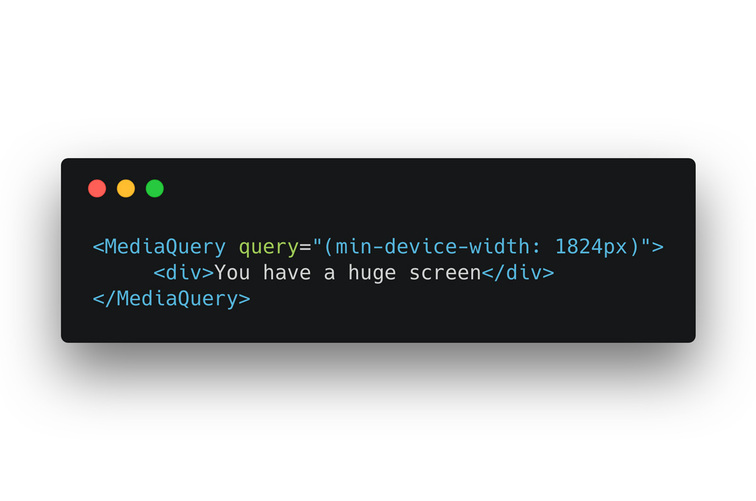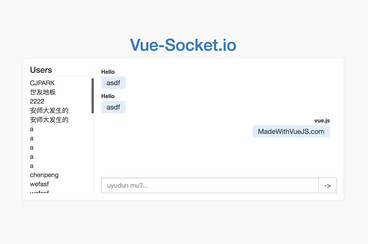React Responsive
made with
React

React Responsive是React的用于响应式设计的媒体查询组件,最受支持、最易用的react media查询模块。
该模块非常简单,用户只需要指定一组要求,如果满足这些要求,则将渲染子项。如果用户调整页面窗口,还可以随之改变。
安装
Npm
npm i react-responsive
Yarn
yarn add react-responsive
使用
使用Hooks
import React from 'react'
import { useMediaQuery } from 'react-responsive'
const Example = () => {
const isDesktopOrLaptop = useMediaQuery({
query: '(min-device-width: 1224px)'
})
const isBigScreen = useMediaQuery({ query: '(min-device-width: 1824px)' })
const isTabletOrMobile = useMediaQuery({ query: '(max-width: 1224px)' })
const isTabletOrMobileDevice = useMediaQuery({
query: '(max-device-width: 1224px)'
})
const isPortrait = useMediaQuery({ query: '(orientation: portrait)' })
const isRetina = useMediaQuery({ query: '(min-resolution: 2dppx)' })
return (
<div>
<h1>Device Test!</h1>
{isDesktopOrLaptop && <>
<p>You are a desktop or laptop</p>
{isBigScreen && <p>You also have a huge screen</p>}
{isTabletOrMobile && <p>You are sized like a tablet or mobile phone though</p>}
</>}
{isTabletOrMobileDevice && <p>You are a tablet or mobile phone</p>}
<p>Your are in {isPortrait ? 'portrait' : 'landscape'} orientation</p>
{isRetina && <p>You are retina</p>}
</div>
)
}
使用组件
import MediaQuery from 'react-responsive'
const Example = () => (
<div>
<h1>Device Test!</h1>
<MediaQuery minDeviceWidth={1224} device={{ deviceWidth: 1600 }}>
<p>You are a desktop or laptop</p>
<MediaQuery minDeviceWidth={1824}>
<p>You also have a huge screen</p>
</MediaQuery>
</MediaQuery>
<MediaQuery minResolution='2dppx'>
{/* You can also use a function (render prop) as a child */}
{(matches) =>
matches
? <p>You are retina</p>
: <p>You are not retina</p>
}
</MediaQuery>
</div>
)
API
使用属性
为了适应react,你可以使用驼峰格式来构造media查询(如使用minDeviceWidth 代替 min-device-width)。所有可能缩写参见https://github.com/contra/react-responsive/blob/master/src/mediaQuery.js#L9。
作为缩写,任何数字都会添加'px'单位(1234 -> '1234px')。之前例子中的CSS media查询可以这样写:
import React from 'react'
import { useMediaQuery } from 'react-responsive'
const Example = () => {
const isDesktopOrLaptop = useMediaQuery({ minDeviceWidth: 1224 })
const isBigScreen = useMediaQuery({ minDeviceWidth: 1824 })
const isTabletOrMobile = useMediaQuery({ maxWidth: 1224 })
const isTabletOrMobileDevice = useMediaQuery({ maxDeviceWidth: 1224 })
const isPortrait = useMediaQuery({ orientation: 'portrait' })
const isRetina = useMediaQuery({ minResolution: '2dppx' })
return (
<div>
...
</div>
)
}
使用device属性强制指定设备
有时,可能需要渲染具有不同设备设置的组件,而不是自动检测到的组件。这在无法检测到这些设置(SSR)或用于测试的Node环境中尤为有用。
可能的key包括 orientation、 scan、 aspectRatio、 deviceAspectRatio、height、deviceHeight、 width、deviceWidth、 color、 colorIndex、 monochrome、 resolution 和type。
其中可能的Type可以是all、 grid、 aural、 braille、 handheld、 print、 projection、screen、 tty、 tv 或embossed
注:
device属性总是优先应用,甚至在可以检查到设备的时候(window.matchMedia存在时)
import { useMediaQuery } from 'react-responsive'
const Example = () => {
const isDesktopOrLaptop = useMediaQuery(
{ minDeviceWidth: 1224 },
{ deviceWidth: 1600 } // `device` prop
)
return (
<div>
{isDesktopOrLaptop &&
<p>
this will always get rendered even if device is shorter than 1224px,
that's because we overrode device settings with 'deviceWidth: 1600'.
</p>
}
</div>
)
}
通过上下文指定
你还可以通过React上下文(Context)将device传递给组件树中的每个useMediaQuery hook。这将简化server-side-rendering和Node环境中的测试,例如:
服务端渲染
import { Context as ResponsiveContext } from 'react-responsive'
import { renderToString } from 'react-dom/server'
import App from './App'
...
// Context is just a regular React Context component, it accepts a `value` prop to be passed to consuming components
const mobileApp = renderToString(
<ResponsiveContext.Provider value={{ width: 500 }}>
<App />
</ResponsiveContext.Provider>
)
...
测试
import { Context as ResponsiveContext } from 'react-responsive'
import { render } from '@testing-library/react'
import ProductsListing from './ProductsListing'
describe('ProductsListing', () => {
test('matches the snapshot', () => {
const { container: mobile } = render(
<ResponsiveContext.Provider value={{ width: 300 }}>
<ProductsListing />
</ResponsiveContext.Provider>
)
expect(mobile).toMatchSnapshot()
const { container: desktop } = render(
<ResponsiveContext.Provider value={{ width: 1000 }}>
<ProductsListing />
</ResponsiveContext.Provider>
)
expect(desktop).toMatchSnapshot()
})
})
注意,如果有
deviceprop传入,它将优先于上下文中的device。
onChange
可以使用onChange回调来指定当media 查询的值更改时将调用的更改处理程序。
import React from 'react'
import { useMediaQuery } from 'react-responsive'
const Example = () => {
const handleMediaQueryChange = (matches) => {
// matches will be true or false based on the value for the media query
}
const isDesktopOrLaptop = useMediaQuery(
{ minDeviceWidth: 1224 }, undefined, handleMediaQueryChange
);
return (
<div>
...
</div>
)
}
import React from 'react'
import MediaQuery from 'react-responsive'
const Example = () => {
const handleMediaQueryChange = (matches) => {
// matches will be true or false based on the value for the media query
}
return (
<MediaQuery minDeviceWidth={1224} onChange={handleMediaQueryChange}>
...
</MediaQuery>
)
}
简易模式
现在,你可以创建特定于应用程序的断点并轻松地重用它们。以下是一个例子:
import { useMediaQuery } from 'react-responsive'
const Desktop = ({ children }) => {
const isDesktop = useMediaQuery({ minWidth: 992 })
return isDesktop ? children : null
}
const Tablet = ({ children }) => {
const isTablet = useMediaQuery({ minWidth: 768, maxWidth: 991 })
return isTablet ? children : null
}
const Mobile = ({ children }) => {
const isMobile = useMediaQuery({ maxWidth: 767 })
return isMobile ? children : null
}
const Default = ({ children }) => {
const isNotMobile = useMediaQuery({ minWidth: 768 })
return isNotMobile ? children : null
}
const Example = () => (
<div>
<Desktop>Desktop or laptop</Desktop>
<Tablet>Tablet</Tablet>
<Mobile>Mobile</Mobile>
<Default>Not mobile (desktop or laptop or tablet)</Default>
</div>
)
export default Example
Eric Schoffstall
@contrahacks相关项目






